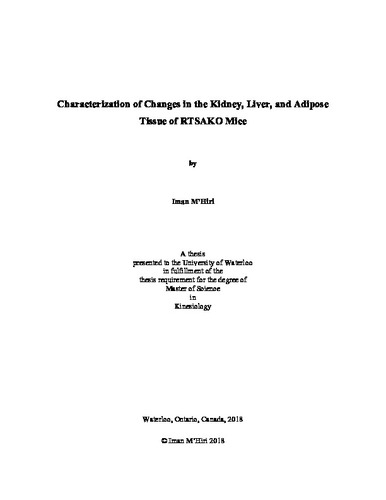| dc.description.abstract | Our laboratory has developed a novel genetic mouse model with kidney-specific lipid
accumulation called RTSAKOs. The principle aim of my thesis was to study differences in the expression
of genes and proteins related to fat and glucose metabolism in the kidneys, liver, and adipose of these
mice before (9-12wks), during (16-18wks), and after (23-25wks) the onset of glucose intolerance, and
compare their expression profiles to age-matched control littermates.
At 9-12 weeks of age, few significant differences in the expression of glucose and lipid regulators
were evident in the kidneys or livers of knockouts. RTSAKO kidneys had significantly lower Dgat1
expression, and the livers showed significantly lower G6Pase, Hk2, Hk3, and Cd36 expression.
Interestingly, all RTSAKO adipose depots studied at this time point had reduced expression of adipogenic
marker gene expression, coupled with low lipolysis and lipogenesis gene expression, which indicates that
preadipocyte differentiation was likely inhibited.
At 16-18 weeks, male RTSAKO mice had significantly more activated pro-lipolytic PHSL S660,
and lower renal lipogenic gene expression, as observed by 35% lower Fas and Lipin1 expression relative
to controls. Furthermore, RTSAKO livers had significantly higher Hk2 expression, as well as lower
Dgat1, Dgat2, and Fas expression in knockouts relative to controls. Interestingly, adipose depots assessed
at this time point showed no significant differences in lipid regulating gene expression in any of the four
depots analyzed.
At age 23-25 weeks, RTSAKO mice had higher renal Sglt2 gene expression relative to control
littermates, and knockout livers had significantly higher G6Pase and significantly lower Gck gene
expression in comparison to controls. Subcutaneous depots in the gluteal and gluteofemoral regions
showed higher expression of Fabp4 and Pparγ.
Expression comparisons between knockouts and controls will aid in the characterization of this
mouse model and are important for understanding renal steatosis. | en |

